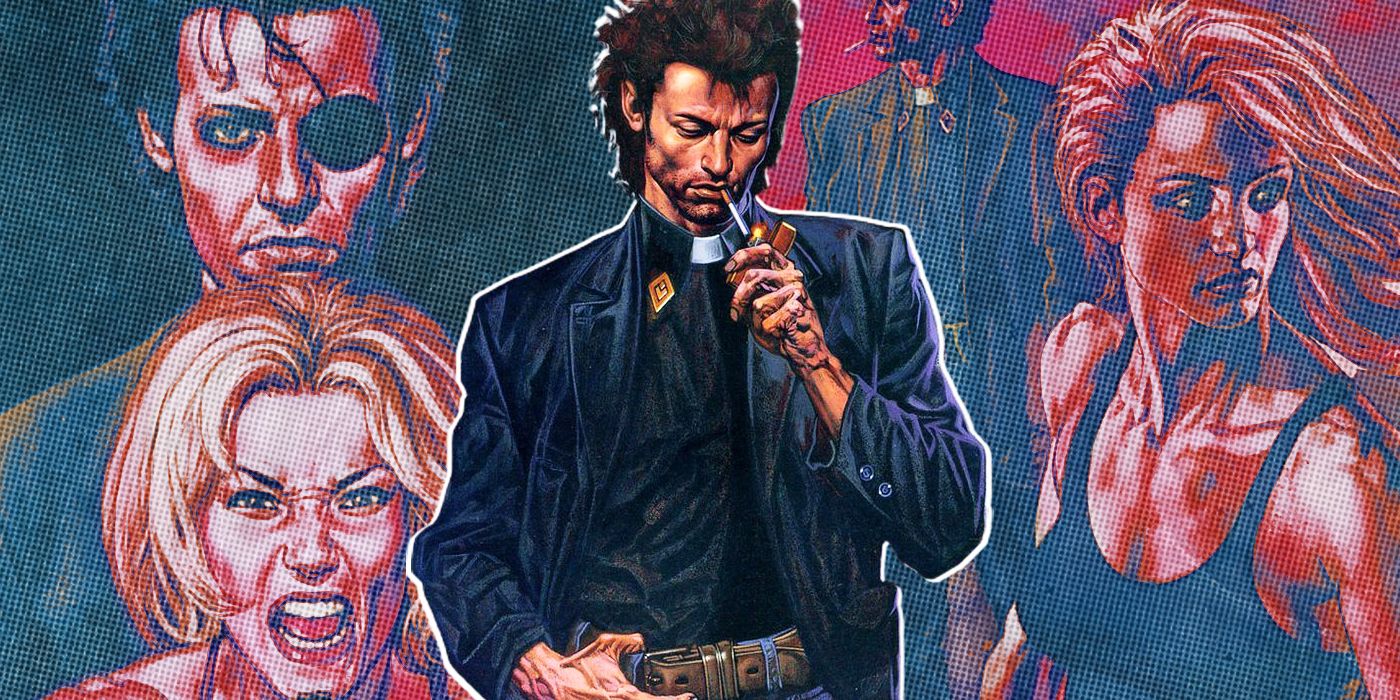Preacher debuted in 1995 when DC’s two-year-old Vertigo imprint was at the height of its power. The book made a huge splash right from the beginning, with the former creative team of Hellblazer, Garth Ennis and Steve Dillon, telling the tale of Jesse Custer. A preacher with a faith problem, Jesse accidentally killed his entire congregation when the half-angel, half-demon entity Genesis possessed him. Given the power to control anyone with his voice, Custer learns that God has left Heaven and teams up with his girlfriend Tulip O’Hare and Irish vampire Proinsias Cassidy to find him.
Preacher took the freedom that Vertigo gave its creators and ran wild with it. While the book is mostly known for its over the top violence and profanity, it’s actually a rather touching love story at its core. A big part of Preacher, though, is Jesse dealing with the toxic masculinity he’s internalized and how it causes him to doubt Tulip’s abilities. It was one of the first titles to call out toxic masculinity, giving Preacher a legacy that makes it very important to the modern comic industry.
RELATED: Did DC License Out Its Characters to Other Companies During World War II?
Preacher’s Ancient History
DC has always led the way in comics. DC creators created the first superhero and the first major superhero team and the company’s creators kept up that pioneering spirit throughout its existence. In the mid-’80s, DC creators like Alan Moore were pushing the boundaries of what comics could be. There had been mature comics before; most notably the underground “comix” of the 1960s, where creators like Robert Crumb tapped into the counter-cultural vibe of the time. However, even the edgy horror comics of the 1950s were largely simpler tales of good and evil that didn’t delve into moral complexity.
Moore’s success with Swamp Thing helped lead to DC’s British Invasion of the late ’80s. This influx of talent from the United Kingdom changed comics forever, bringing in some of the best comic creators of all time. Books like The Sandman, Doom Patrol, Animal Man, Hellblazer, and Shade The Changing Man took DC’s readers to entirely new places, and added the kind of mature storytelling that wasn’t often on display in the mainstream US comics industry. While this often meant more graphic violence, which helped DC remain the purveyor of the best horror comics, it also meant digging deeper into the human psyche and talking about things that make everyone tick.
REALTED: A Forgotten DC Comics Anthology Series is Perfect for a Comeback
The Sandman led the way, appealing to a huge range of readers, including fans who didn’t typically read comics. Soon, these same readers started to buy more of the “sophisticated suspense” stories that DC was putting out, which led to the 1993 debut of DC’s Vertigo imprint. Vertigo changed the game in every way and was a precursor to companies like Image today. Thanks to the success of the British Invasion, DC kept bringing over more creators from the British Isles, including writer Garth Ennis and artist Steve Dillon. Ennis and Dillon made a splash on Hellblazer starting with “Dangerous Habits,” where John Constantine learned he had terminal lung cancer and conned the lords of Hell into curing him. Ennis and Dillon proved they were an amazing team during their Hellblazer run, and Ennis also got a job writing The Demon at the time.
The thing about Ennis’s writing is that it while it can seem a bit juvenile, filled with gratuitous violence, nudity, and profanity, it’s also sometimes profound. Ennis understands how to write in layers. On the surface, he gives readers the kind of adult violence, sex, and humor that pull people in, but a little deeper in, he tapped into elements of the human condition — fear of death, love, hate, and religion. Ennis had no problem slaughtering people’s sacred cows and this made him a writer to watch. Dillon’s art was the perfect accouterment to Ennis’s writing, as his style lent itself well to be both realistic portrayals of terrible violence and the kind of character acting that made a story really connect with fans. Preacher presented both of them at the top of their games and it rarely disappointed its core audience.
The Sandman ended in 1996, and everyone wondered what Vertigo book could possibly replace it. There was a lot of competition, at the time; Hellblazer was still going strong and Grant Morrison’s The Invisibles has survived its early years to become an integral part of the line. However, thanks in part to its being a favorite of Wizard magazine’s staff, Preacher took that crown. It had a little something for everyone. It had the violence, profanity, and humor that Ennis and Dillon did so well, but there was more to it than that. Preacher is an intensely humanist work, despite being centered around religion. At its core, it’s all about people and the terrible and wonderful things they can do. It was staunchly anti-religion, but it was never as cynical as some other atheistic works. A big part of its success was the book’s focus on the relationship between the three central characters, Jesse, Tulip, and Cassidy.
RELATED: Who is the Youngest Superhero in DC Comics?
Until The End Of The World
The love story of Jesse and Tulip is Preacher‘s key relationship. They met as teenagers, when Jesse had escaped the clutches of his fanatically religious grandmother Marie L’angell, and were separated when his grandmother’s thugs, Jodie and T.C., found him and threatened Tulip’s life. This moment was important in their future, as it made Jesse feel responsible for Tulip’s life. Jesse was raised on a steady diet of John Wayne movies and, despite his protestations, a uniquely Southern Baptist take on Christianity. Jesse internalized a lot of the misogyny that was a part of the culture he was raised in, and this extended to his later relationship with Tulip. Jesse’s quest to find God proved to be dangerous right from the word go when the Saint Of Killers was sent to kill Jesse to release Genesis. Jesse felt he was responsible for Tulip’s safety, despite the fact that she was tough as nails and guns were a part of her DNA.
In Preacher‘s second story arc, Until The End Of The World, readers learned Jesse’s history with his parents and grandmother, as well as the early days of his relationship with Tulip. Jodie, under orders from Marie, shot Tulip in the head, killing her. God resurrected Tulip to convince Jesse to stop looking for him. This moment devastated Jesse, and it changed the way he saw Tulip and her skills throughout the rest of the series. In Crusaders, Cassidy was captured by a secret society called The Grail, mistaking him for Jesse, which caused Custer to go to France after him. Instead of bringing Tulip with him to attack the Grail facility at Masada, he left Tulip behind. This caused a schism between the two, and Tulip returned to the US to get away from Jesse’s lack of regard for her.
RELATED: Why Jack Kirby’s Most Underrated DC Series Will Always Be His Most Obscure
The surprising part is the fact that Jesse learned a lesson from this and promised to never leave Tulip out of his life again. He’s mostly true to his word after this and Tulip shows him why he was dumb to leave her behind in the first place by constantly saving him and Cassidy in their adventures in New Orleans. After the Battle of Monument Valley, Cassidy and Tulip believed that Jesse was dead and ended up together and Cassidy manipulated Tulip with drugs and alcohol, taking advantage of her heartache. She escaped him and found Jesse again, and they were able to reunite for the series finale, Alamo, where they prepared for their final showdown with The Grail before Jesse drugged Tulip and went out to face his death on his own.
Tulip woke up and went after Jesse, slaughtering The Grail’s forces while Jesse fought with Cassidy, even killing Herr Starr, the Grail’s leader, and the series’ big bad. The book constantly showed readers and Jesse just how wrong he was to doubt Tulip, but in the end, his fear brought his toxic masculinity back to the fore. Preacher used the story of Tulip and Jesse to illustrate the perils of toxic masculinity before the term was well-known. In the ’90s, there were still plenty of sexist stories about powerful women from Marvel and DC. There were plenty of formidable women in comics, but they often seemed vulnerable in ways that their male equivalents weren’t. Preacher did the exact opposite. It constantly showed Tulip being just as deadly as her male counterparts, showing why Jesse’s need to protect her was wrong. She could not only protect herself, but she could protect him as well.
What makes this all the better is that Preacher didn’t feel like The Sandman. The Sandman was a thoughtful comic for introspective goths and had a massive female readership. Preacher, in many ways, seemed to be Sandman‘s opposite. It was a loud, profane, and violent comic that wore its love of Americana on its sleeve, the kind of book that appealed to teenage boys and macho male adults. Its audience was attracted by the over the top action that Ennis and Dillon delivered to them even as they were unknowingly exposed to a comic that taught them that men saving women was completely false; anyone could save anyone else and gender didn’t matter. The book made a pretty big feminist statement, but it was also the last book anyone would have expected to make it.
RELATED: Jack Kirby’s Greatest Creation Needs A Resurrection In DC Comics
Preaching A New Gospel
Read from a 2020s perspective, there’s still plenty of offensive content in Preacher, but that same statement could be made about many of the most important comics of the last forty some-odd years. However, that doesn’t change the impact that book had on its audience. No one was using the phrase “toxic masculinity” in the ’90s, especially not in comic books. Comics have often been a place of repressive gender-related morals, as superheroines like Stephanie Brown have never been given the respect they deserve, even to this day. Preacher made a very explicit statement about feminism and masculinity and it did for an audience who needed to hear it.
Vertigo books were always known for being ahead of the curve on issues of sexuality and gender, but Preacher was the last book anyone expected to take a stand against toxic masculinity. On the surface, it’s a book about a red-blooded Texan hunting down God himself, and fist-fighting his way through everything from crooked sheriffs and politicians to an international conspiracy that controls governments. Many of the book’s fans were there for the overtly perverse battles, not the message that Jesse’s toxic masculinity was holding him back. However, Ennis and Dillon were able to weave this message throughout the book, making Preacher ahead of its time and an ancestor of today’s more interesting and accepting comics.
Garth Ennis and Steve Dillon created Preacher as a twisted macho Western. Despite its problems, striking out against toxic masculinity was its core. Read More

